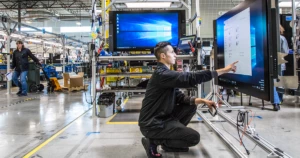
3 Business Questions to Ask When Implementing IoT Solutions
Connecting your business with the Internet of Things (IoT) enables endless opportunities. And yet, business owners and executives are also finding it can pose unique challenges. At the heart of this transformation process is the question: “How do I successfully apply IoT to my business?”
Often this is a weighted question. Affecting it are concerns about ROI, getting the workforce on board, navigating the complexities of integration and scale – the list goes on.
The path to success starts with learning from others about how they used IoT solutions to reshape and transform their business. You can hear firsthand how other businesses have successfully seized on the IoT opportunity with the IoT in Action Business Transformation webinar series. Available in three parts, this webinar series covers new business models, workforce transformation, and supercharging the P&L all within the framework of IoT digital transformation.
Applying IoT to Business Transformation
IoT-enabled digital transformation comes about through the combination of several technologies – for example, cloud-based computing, big data collection, and processing – and plays an increasingly important role in shaping how businesses take their goods and services to market, or how they themselves operate.
We can think about business transformation as a series of stages. At each stage, your journey may take a different route from someone else, but in the end, we are all working toward the same destination: to use IoT to lower costs and increase profits.
Setting the Stage for Success
To begin a successful IoT digital transformation process, businesses should ask themselves three questions:
1. What problem am I trying to solve?
If you are a business that remains reactive while the rest of your competitors are solving their problems proactively, you’re going to find it harder and harder to compete. Then as you begin to think through service offerings, it is important to understand the models for how people develop an offering in an IoT world. It is crucial to understand where the value add is in the solution stack in each model, where the costs are going to be incurred, and how the models differ between the offerings in these two spaces: SaaS and PaaS.
Explore more in-depth how IoT digital transformations are changing business models and consumer expectations, and why it’s so important that you take this first crucial step in the first part of the webinar series: From Digital Transformation to New Business Models.
2. How do I empower my workforce to succeed during this digital transformation?
IoT-based digital transformations can help reduce inefficiency by first producing it and then remedying it before it becomes a larger problem. As such, you must start thinking of your workforce as a vital asset in producing failure. After all, it is these same failures that will help innovate and advance your business models to give you a competitive edge in the marketplace.
If you are to empower your employees – and respectively your business – to succeed in a competitive marketplace, you need to start by reconceptualizing your workforce to be willing to fail to succeed. Discover the many opportunities that exist for workforce transformations at all levels of an organization in the IoT and Workforce Transformation webinar, part two of the webinar series.
3. Have I considered all the ways my investment in IoT can impact my P&L?
An investment in IoT can be significant. It’s important, though, that you consider more than the initial costs. While you will have some new expenses associated with new hardware, research and development, cloud hosting expenses, etc., you are setting the stage for advanced analytics to power your new solution.
One to two years into the IoT transition might generate new revenues, but the total gains and boost in revenue might not be evident until five-plus years in. Attend the third part of the webinar series, Supercharging the P&L, to explore the ways in which your investment in IoT can generate savings, as well as the impact new revenues and cost savings can have on your operating and gross margins.
Embarking down the path of digital transformation can be a long process. Yet taking the time to think through how IoT is changing the way you do business – from pricing through staffing, partnerships, and marketing – can significantly impact the outcome. Discover other ways IoT solutions are being used across businesses and industries with Microsoft’s IoT in Action webinar series.




